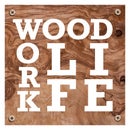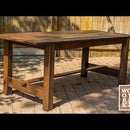Introduction: Reclaimed Pallet Wood Sign - for My Baby
They grow up so fast! My youngest is turning one, and of course in modern fashion we are doing it BIG. So I had a bunch of items on my honey do list lately, this was the one I was most happy with.
My wife wanted to make a sort of smash cake throne for Marigold to get those perfect pictures, so that someday she will remember how good of parents we were...
She asked me to make a sign to hang up behind the smash throne so I looked around the shop to see what I could make. I could've carved the sign into a piece of hardwood with a router but I wanted to do something different. So I grabbed the pallet that my new table saw was shipped on, and went to town.
Vote for this project in the outdoor structures competition if you liked it.
Materials you will need:
A pallet, (these can be scored for free from your local big box store.)
A piece of scrap plywood (at least half an inch, the more plys the better, so like birch ideally)
Tools you will need:
A brad nailer (or a hammer and finish nails)
A palm sander (optional)
A circular saw (optional)
Step 1: Breakdown the Pallet
There are SO many ways to break down a pallet, and to me it really depends on the species of the wood you are trying to salvage. Some pallets use for shipping big old steel machines, and raw materials have some really rare hardwoods in them. In which case you may want to invest in a pallet breakdown tool if you have a good source for these.
Otherwise just have at it, a hammer, a crowbar, a circular saw, a jigsaw whatever works. One pallet disassembled hastily is enough for two of these signs.
Step 2: Nail the Pallet Wood to a Plywood Backer Board
You could joint and plain and mill and blah, blah, blah this lumber and glue up a nice panel out the pallet wood. But at the end of the day it is pallet wood. I use an 18 gauge pin nailer to affix my board to a plywood backer board. This doesn't need to be anything special but the more plys the sheet has thinner the plywood you can use, and the narrower the details in your text can be while maintaining structural integrity.
Only nail the boards at the edges of the plywood far away from where you are going to be laying out your text, this way these nails won't screw up your blade.
Step 3: Layout Your Text and Nail Down the Field
Of course you could cheat and lay this all out in some adorable print from Adobe Typekits in Illustrator print it out in large scale at Kinkos and work from that as a template. For a more rustic, personal touch I like to layout the text by hand. First with pencil and then with chalk.
Pro Tip: Scuffing up the pallet wood with 40 grit sandpaper makes drawing on the pallet wood a lot more palatable and makes for a lot less splinters.
With the pencil I try out a bunch of things to see what works best for scale, and proportion. Once I am happy with the layout I draw out my final lines with chalk so it is easier to see when I am going over it with a jigsaw.
Once you are set on your design, go back over with your brad nailer and nail down the field of your letters. We waited until this step to do this to make sure we wouldn't have to cut through any nails with the jigsaw. That could be a bad day.
Step 4: Removing the Waste With a Jigsaw
The next step is removing all of the waste with a jigsaw. This can be a breeze, or a nightmare depending on following a couple of the tips below. I don't cut exactly to the line because I want some extra material to work with to make sure the proportions look right in the final product. After I remove all the waste I step back and look at the finished product and mark any areas that look out of proportion to go back in and remove some more material. It is a lot easier to remove material than to put it back on.
1. Go S-L-O-W, let the blade do the cutting, using a lower toot h count blade will allow you to go a little bit quicker but don't push against the blade.
2. Buy good blades, not great, just good enough. I use the Bosch blades, they are cheap enough and I have not had a problem with any of their different variations.
3. Work in LONG sweeping motions rather than short choppy motions. Even if you are not perfectly hitting the line, the smooth movements will look better than changing directions every couple inches in the final product.
4. Work in tight corners in multiple steps. Think of it as a 3 point turn in your car, don't force the tool to operate inside of its "turn radius." If you doing a lot of tight curves in a project consider using a narrower blade or a scroll cutting blade to make tighter turns.
5. Remove the waste as you go. This will be safer, the blade will work more efficiently with less friction (heat) and it will just be easier than try to get the whole thing in one swoop.
Step 5: Remove the Inside of the Letters, Paint, and Sand
This step is all up to personal preference. You can remove the "field" of your letters by drilling some holes, and hogging out material with a jigsaw, or you can use a router to remove some of the material. You can paint the wood, or not. You can do a bunch of sanding, or not.
I painted the negative space of each letter with black spray paint, then I went over everything with some gold, then a final light coat of white. I think of layered paint colors in this way, The first coat is either an underlying background color, or something you are going to sand all the way down to, the second coat/middle coats are going to be the bulk of the color left on the project, the third final coat is going to be that accent color, since it will remain in all of those hard to sand areas.
I scuffed the surface of the letter with 80 grits sand paper after the spray paint dried and did all of the details by hand.
Step 6: Enjoy
Much as Marigold enjoyed this cake. Enjoy your sign. We accented ours with some dollar store "poufs."
Thanks for checking out this Inventables. I also have a YouTube channel where I post some other cool stuff.





